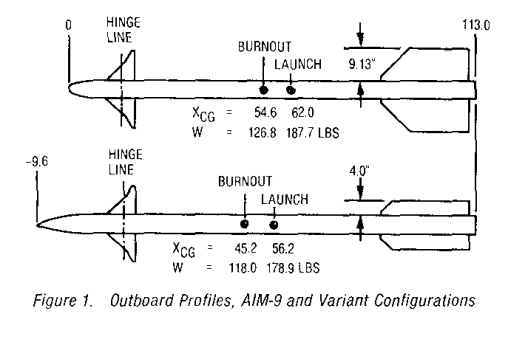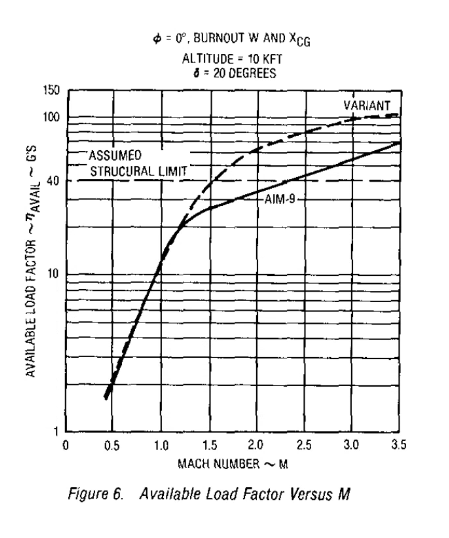-
Posts
1517 -
Joined
-
Last visited
Content Type
Profiles
Forums
Events
Everything posted by nighthawk2174
-
Yeah... not enough information out there on the C7, a shame but that is the situation with the missile.
-
Aren't we waiting for HB to decide whether the C should have AMRAAM-like guidance? They've already said it will be changing to have command inertial like the amraam.
-
As far as i'm aware were just still waiting for the 54 to make it onto the new missile API.
-
Also could be that the speed on the chart is speed above initial launch speed, which may not be 0. Without exact start conditions hard to say.
-
Original posts meant to say 1600kph like in your original image that was a mistake on my end. And that's the number I was working with when writing up my posts. I accidently just wrote 1100kph sorry about that. From the standard atmosphere table air density for standard day at 3000ft is ~1.1226 kg/m^3. Also fair some value between 25 and 30G is probably accurate for M1.3 for the chart. However when brought down to 3000ft from 10000ft 30-35g is probably accurate and is why I said 30-33G in my last post. I probably should have clarified that. I'm not saying its completely valid but rather that it is a rough indication that the amraam's performance in game is not impossible. That's always what I meant by the use of the charts essentially just to say hey we have a rough analog here and it can reach nearly to the loading values seen in game at roughly the same speeds, when the fact the chart is for 10,000ft is considered. There are additional factors, which I'll mention below, that can make up the difference if any. Something else to consider is iirc the 120's fins can deflect more than the sidewinders but don't quote me on that. I want to say in game its 25deg, I could ofc be very wrong. But if I am correct this would allow the missile to pull higher aoa and as such a get a higher Cl. Tail control instead of nose control also would help getting to higher aoa's as well iirc. Something else for the chart as well is that as far as I can tell this is for 0deg of roll. And that for this paper 0deg roll means that if you were to look from the rear of the missile the fins would look like a + where if they were X in orientation you would get additional lift from the missile increasing the Gload further.
-
The "variant" line is going to be more along the lines of an amraam due to being more similar in shape and at M1.3 its about 30-33G at M1.3. Also the chart is for 10k feet or just over 3km.
-

Active Missile Look Down Notch Width Seems Excessive
nighthawk2174 replied to nighthawk2174's topic in Weapon Bugs
Right, and Iisted a bunch of technologies and various qualities of PD radars and monopulse systems that are specifically able (if not outright developed) to counter notching to make it borderline impossible to happen. Again not impossible just a 1 in a million chance. One of the sources I posted is a literal Raytheon patent from the early 80's. You have yet to post anything more than your opinion. There have been a bunch of tacviews and tracks posted, and flying competitive it is more than a common sight to see people just notching amraams left right and center. Hec examples are posted in the first post of this thread. Now as a disclaimer I haven't played the latest patch so it may be better. But as of the last time I played it was pure child play to notch amraams so I have no clue what your seeing. Especially in MP. When I tested with friends before making this thread it was nearly a 100% success rate with notching so long as I wasn't an idiot and completely botched the maneuver. I watched your tacviews and here's my notes. In the first one you did notch the missile at ~25sec and it began reducing G slowly (new AP lets of G slowly) but then it reacquired at 28sec. Which is a dice roll if it happens it doesn't happen often. So you did infact notch the missile the moment you reduced closure below 100kts. You can tell as the G suddenly spikes from ~2G to 4.5G and stays high for the rest of the intercept. For the second you just got unlucky, you did notch the missile at ~29 sec. And it started to fly straight it may have been flying on datalink hard to tell, G reduced to nearly 1G and it was flying straight for about 7sec. However you flew so level in straight it was essentially going to hit you ballistically. Now when it got closer to you it seems to have reaquired for just the briefest of moments at 38sec and that gave it just enough time to pull onto you. So for this one I think you just got unlucky due to flying so straight and level that you flew right into the PIP. For the last two the moment you got below 100kts of closure they were immediately notched. And did not require and were not in a position to essentially hit you ballistically. Proving exactly what was posted in my original post I might add. Which based off of all the documents we have is not how it should work. -
-
Reaching up to 35G at that speed is probably not unreasonable we have gloading charts available for an AIM-9 with an AIM-120 style nose cone and much smaller fins and it was fully capable of reaching its structural G-limit of 40G at speeds as low as 1100kph.
-

reported AIM120 odd behaviour (Target selection on pitbull)
nighthawk2174 replied to falcon_120's topic in Weapon Bugs
I've been told the exact opposite very clearly so no I know it is in fact a thing that is trained too. -

reported AIM-120s + All AIM-120 API Missiles in 2.7.7
nighthawk2174 replied to DSplayer's topic in Weapon Bugs
Good lets hope that this issue gets fixed soon. -
ED level issue
-

reported AIM-120s + All AIM-120 API Missiles in 2.7.7
nighthawk2174 replied to DSplayer's topic in Weapon Bugs
Not the tomcat specifically, i just did a competitive match and against every jet we say the behavior above. Ontop of that ECM usage is not allowed and it was still doing the behavior we've been seeing: Tacview-20211031-100758-DCS-S21_Gud-Min.zip.acmi -
Не могли бы вы поделиться этими документами? Я бы с удовольствием взглянул на них!
-

reported AIM120 odd behaviour (Target selection on pitbull)
nighthawk2174 replied to falcon_120's topic in Weapon Bugs
All of them are ITAR and a few I was given by people who asked me not to share the files. I wish I could share everything but I can't. I know that the MLU and F16 stuff is easy to find and the F18 radar manual is somewhere out there. In close proximity the seeker will use the datalink updates to compare and track on the desired target. From my current understanding of what's said is that the missile will select the target that best matches the host radars updates in terms of position and speed. So if you have a two ship in a blue angles tight figertip and one suddenly breaks out right as the missile is going active as far as i'm aware the missile should continue on to track the one that went straight. It's less clear what happens after the initial sorting as these specific manuals really only talk about the moment the seeker is searching for the target and if the target is lost due to notch/ECM. This exact situation though probably wouldn't happen at all as the host radar itself probably wouldn't switch onto the new target breaking away as it itself would be able to see there are two targets and that one has a now very different position and Vc while the other matches the predicted location and Vc of the tracked target, simple it would just build a new track/ignore the breakaway contact. In short I don't think this is really an issue. DL could probably get it a lot closer than I think you imagine it would but not close enough to 100% reliably trigger the proxy fuze to not need terminal homing. Plus if contact is lost by the main radar the missile would be just as trashed as a SARH having a seeker on the target eliminates this weakness. If the amraam's warhead was bigger this probably would be a lot more effective but since its a smaller warhead you need to get closer to the target which you need terminal radar homing for. So regardless of how accurate the DL is terminal homing is needed otherwise you might as well just make a sarh missile. Both the F15 and F18 manuals are pretty clear in that datalink updates continue till missile timeout and will be referenced if needed. -

reported AIM120 odd behaviour (Target selection on pitbull)
nighthawk2174 replied to falcon_120's topic in Weapon Bugs
We have multiple manuals from the F15/F16/F18 that all make it explicitly clear that DL continues after pitbull and is referenced by the missile in case of multiple targets in close proximity or if the target fades. -

reported AIM-120s + All AIM-120 API Missiles in 2.7.7
nighthawk2174 replied to DSplayer's topic in Weapon Bugs
Yeah this is an issue that has been present since I started playing back in 2013 think of chaff as long burning flares but for radar missiles. Also its worse than just that, radars are able to essentially ignore returns outside of what's called their resolution cell so it jumping like 4° to the left onto a stationary chaff bundle is even more absurd. Especially if its outside the seekers FOV... Yes yes it should, but its because the systems used on the amraam render chaff pointless. Chaff is a 1940's countermeasure to radars so there has been quite some time for countermeasures to be developed. If chaff is so good why is everyone flying towed decoys now and very modern jets like the F22/F35 carry very few traditional CM's. And btw this applies to the more modern Russian missiles too both the adder and alamo are too sensitive to chaff. While defiantly not as good as the amraam-C it should still be well below a 1% chance against these missiles not what it is now. The amraam just has all of the things with regards to defeating chaff. -

reported AIM120 odd behaviour (Target selection on pitbull)
nighthawk2174 replied to falcon_120's topic in Weapon Bugs
From various manuals we have 1-F15C-34-1, HAF1-F16C-34, MLU, a1-f18ac-nfm-700c, and a few others the datalink updates are not severed at pitbull they continue until missile timeout. What your saying is how it used to work in DCS (well hopefully used too), but that was not accurate. As was said by Harker this allows the missile to have an extra layer (ontop of the already op monopulse stuff) of countermeasures to notching and CCM teqniques. It should be more than good enough to get it close enough that the seeker will be able to get that last little bit of terminal guidance. But yes if your in a 6 bar scan updates will be slow to be sent and it may not be enough if some really lucky (for the bandit) situations. Hence why they often train for STT shots on closely grouped bandits according to the navy's BVR manual that's out there the update rate from STT should be well beyond adequate to get it close enough. Plus getting it close is all that really counts at some point its going to become impossible to notch the amraam's seeker the S/N ratio will be too high and it will be too hard to stay in the notch, in theory this should occur at a few miles from the bandit. Which is more than enough time for the amraam's seeker itself to find/reacquire the target. Monopulse seekers like the one on the amraam should have amazing range and azimuth resolution so getting it close should be well beyond good enough. -

reported AIM120 odd behaviour (Target selection on pitbull)
nighthawk2174 replied to falcon_120's topic in Weapon Bugs
Odd with the datalink now that shouldn't happen, even post pitbull datalink updates are sent to the missile and would prevent this. This is why shooting into furballs with 120's is a thing that can be done IRL. -

reported AIM-120s + All AIM-120 API Missiles in 2.7.7
nighthawk2174 replied to DSplayer's topic in Weapon Bugs
only the amraam got the latest set of INS/Datalink updates. The notch width issue though seems to be a problem across all the missiles. -
The F15 episode of the FPP has two pilots who have both brought the eagle up to over 10g. Both of them talk about doing that, and others who have and they talk about it in a way that indicates it is not a rare occurrence. Just because you go to high G does not mean the airframe falls apart that's not how this works, which is why some of ED's recent changes are not really accurate (again exceptions do apply). Safety margins are a thing, they are hammered into an engineer from day 1 of their classes and its often a 50% safety margin from designed load till you get more permanent deformation. This can and will vary from aircraft to aircraft, but the eagle has shown that it is a strong design and there are a plethora of times where significant overloads were achieved and sustained in flight. Even with weapons and fuel tanks on the aircraft. IRL there are consequences on frame life and that is something worth worrying about in peace time hence why pilots are chewed out for unnecessarily over-g'ing. However taking a few years off the frame life when in combat is well worth brining the frame back and accomplishing your task. Such maneuvers irl are limited by the fact that it's really only possible to pull that many g's once in a flight. The physical effort of doing so is so extreme that doing it over and over again is not possible. Without significant recover time between. If a more realistic G-system was implemented you'd really only get one good pull at that G before not being able to do that again before nearly snapping to black out.
-

Active Missile Look Down Notch Width Seems Excessive
nighthawk2174 replied to nighthawk2174's topic in Weapon Bugs
Agreed this last patch seems to have made it worse. I'd hoped that this issue would have been fixed but unfortunately it hasn't. As I said in my original post notching should be very ineffective against a missile that almost certainly has specific countermeasures against this. Such as STAP or the technique I linked. The reduction in CCM against chaff is also an unpleasant surprise as once again chaff is waaay to effective against missiles. -
As far as i'm aware ED has relevant documentation about the R27's guidance, I have seen some of it however it's in Russian and I haven't had the time to go through the arduous process of translating it. But from what I could understand what has been said about the missile only using raw PN inside of 25km is correct. We are also rather confident about the AIM-7 series using APN and the amraam/54C using optimal control as well.
-

reported AN/APG-63 range is under-represented
nighthawk2174 replied to GGTharos's topic in Flaming Cliffs Bugs & Problems
From the front missiles are relatively small RCS targets but yes 8 R-27's and you'd probably add a few m^2 from the front and a whole lot more from the side. The su30 itself I agree shouldn't be 5m^2 far closer to 15-20 while clean. Maybe closer to 20-30 from the front when fully loaded, probably tending towards the bottom of those ranges for average numbers over the frontal arch. -

reported AN/APG-63 range is under-represented
nighthawk2174 replied to GGTharos's topic in Flaming Cliffs Bugs & Problems
tbf the current DCS implementation of the -73 is almost certainly shorter ranged than it should be.





